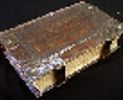
The English Reformers and Martyrs
England in the 1550s, was a religious rollercoaster swinging between Roman Catholicism and Protestantism, dependent on the belief of the current Monarch. In 1553, Mary Tudor, a staunch Roman Catholic, became Queen. She set out vigorously to reinstate the Roman Catholic Church and papal authority. A number of prominent Protestant leaders became victims of her determination to stamp out the Protestant Church. Many Protestant leaders fled to the continent, of those who did not the two most significant were Nicholas Ridley, bishop of London, and Hugh Latimer, bishop of Worcester.
Hugh Latimer
Hugh Latimer, educated at Cambridge was well-known as an outstanding preacher, attacking abuses in the church and social injustice. In recognition of his ability, he became one of only 12 preachers authorised to preach anywhere in England. He had been Roman Catholic, but had came into contact with a group of young Cambridge divines influenced by Martin Luther’s new doctrines. This made the authorities suspect him, but when Thomas Cranmer became archbishop of Canterbury he seemed more secure. Henry VIII appointed him bishop of Worcester in 1535. He resigned in 1539 when his Protestant sympathies led him to oppose Henry’s Six Articles. He returned to public and court favour with the accession of Edward VI in 1547. He continued to denounce abuses in church and society. Mary Tudor on gaining the throne had him arrested and sent to the Tower. He was challenged on various theological issues, he refused to recant.
BORN: 1487,
Thurcaston, Leicestershire, England
Nicholas Ridley
Nicholas Ridley also attended Cambridge University. He was even more for the reformation than Latimer. Ridley was a friend and supporter of Thomas Cranmer. He became Cranmer’s chaplain in 1537, master of Pembroke College in 1540, and a royal chaplain in 1541. His reforming sympathies led to a trial for heresy in 1543, but he was acquitted. In the reign of Edward VI, Ridley became bishop of Rochester, and then in 1550 bishop of London. As bishop of London he carried through the principles of the Reformation, but was arrested when Mary Tudor became queen. Like Latimer he refused to recant his Protestant doctrines, and was taken to Oxford with Latimer, where he was tried, for heresy.
BORN: 1500,
Tynedale, Northumberland, England
The Death together of Latimer and Ridley
DIED: 16 October 1555, They were burned at the stake in Oxford, England. Latimer’s last words to Ridley were prophetic: “Be of good comfort, Master Ridley, and play the man. We shall this day light such a candle, by God’s grace, in England, as I trust shall never be put out.”
 Welcome
Welcome Calendar
Calendar Today's Word
Today's Word Lauds
Lauds Terce
Terce Sext
Sext None
None Vespers
Vespers Compline
Compline Matins
Matins